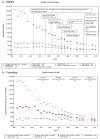Adult mortality trends in Qatar, 1989-2015: National population versus migrants
- PMID: 30252887
- PMCID: PMC6155516
- DOI: 10.1371/journal.pone.0203996
Adult mortality trends in Qatar, 1989-2015: National population versus migrants
Erratum in
-
Correction: Adult mortality trends in Qatar, 1989-2015: National population versus migrants.PLoS One. 2018 Nov 1;13(11):e0207104. doi: 10.1371/journal.pone.0207104. eCollection 2018. PLoS One. 2018. PMID: 30383863 Free PMC article.
Abstract
Introduction: With the increase of Qatar's total population, primarily due to the influx of healthy male migrant labor, worldwide attention has been focused on deaths among these migrant workers.
Objective: To describe adult mortality trends in Qataris (nationals) and non-Qataris (migrants) from all causes, cardiovascular and circulatory disease, neoplasms, and injuries, 1989-2015.
Methods: We retrieved Qatar's vital registration data by nationality, sex, age group, year, and codes of the World Health Organization's International Classification of Diseases, Ninth and Tenth Revisions. We assessed age-standardized mortality rate (ASMR) trends in Qatar's total population, in Qataris and non-Qataris using Joinpoint regression.
Findings: During the study period, 26,673 deaths were recorded. In 2015, we estimated 60,716 years of life lost (82% in males) in the overall population. In Qataris (both sexes) and in non-Qatari females, all-cause rate decreased significantly and steadily between 1989-2015. In non-Qatari males, it decreased significantly between 1998-2010 probably attributed to a massive influx of healthy migrants. Yearly rates were significantly lower in non-Qataris over 27 years. Reduction in Qatar's total population rates for all causes and for neoplasms can be partially attributed to the healthy migrant effect. For injuries in males, it was lower in non-Qatari. Remarkably, for falls, cause-specific ASMR in non-Qatari males decreased significantly reaching 2.6/100,000 in 2014, suggesting improved safety in the work environment. However, while young adult males in Qatar die predominantly from injuries, young adult females die from neoplasms.
Conclusion: Our study demonstrates that premature death in young adult males and females in Qatar is predominantly due to injuries and neoplasms respectively. These identified causes of death are for a large part preventable and should be addressed appropriately to lower premature mortality among young adults in Qatar.
Conflict of interest statement
The authors have declared that no competing interests exist.
Figures

Similar articles
-
Core health indicators in countries with high proportion of expatriates: Case study of Qatar.Front Public Health. 2023 Feb 7;11:1035686. doi: 10.3389/fpubh.2023.1035686. eCollection 2023. Front Public Health. 2023. PMID: 36825143 Free PMC article.
-
Assessing the impact of annual health screenings in identifying noncommunicable disease risk factors within Qatar's primary health care corporation Qatari registered population.Front Public Health. 2024 May 23;12:1305636. doi: 10.3389/fpubh.2024.1305636. eCollection 2024. Front Public Health. 2024. PMID: 38846608 Free PMC article.
-
Determinants of healthcare utilisation by migrant workers in the State of Qatar.Health Policy. 2020 Aug;124(8):873-880. doi: 10.1016/j.healthpol.2020.04.011. Epub 2020 May 23. Health Policy. 2020. PMID: 32532567
-
[SENTIERI - Epidemiological Study of Residents in National Priority Contaminated Sites. Sixth Report].Epidemiol Prev. 2023 Jan-Apr;47(1-2 Suppl 1):1-286. doi: 10.19191/EP23.1-2-S1.003. Epidemiol Prev. 2023. PMID: 36825373 Italian.
-
Current status of stroke in Qatar: Including data from the BRAINS study.JRSM Cardiovasc Dis. 2019 Aug 18;8:2048004019869160. doi: 10.1177/2048004019869160. eCollection 2019 Jan-Dec. JRSM Cardiovasc Dis. 2019. PMID: 31452875 Free PMC article. Review.
Cited by
-
Correction: Adult mortality trends in Qatar, 1989-2015: National population versus migrants.PLoS One. 2018 Nov 1;13(11):e0207104. doi: 10.1371/journal.pone.0207104. eCollection 2018. PLoS One. 2018. PMID: 30383863 Free PMC article.
-
Depression among healthcare workers in the Eastern Mediterranean Region: a systematic review and meta-analysis.Hum Resour Health. 2021 Jul 10;19(1):81. doi: 10.1186/s12960-021-00628-6. Hum Resour Health. 2021. PMID: 34246282 Free PMC article.
-
Facemask use in community settings to prevent respiratory infection transmission: A rapid review and meta-analysis.Int J Infect Dis. 2021 Mar;104:198-206. doi: 10.1016/j.ijid.2020.09.1434. Epub 2020 Sep 26. Int J Infect Dis. 2021. PMID: 32987183 Free PMC article. Review.
-
Core health indicators in countries with high proportion of expatriates: Case study of Qatar.Front Public Health. 2023 Feb 7;11:1035686. doi: 10.3389/fpubh.2023.1035686. eCollection 2023. Front Public Health. 2023. PMID: 36825143 Free PMC article.
-
A cross-sectional analysis of zinc and copper levels and their relationship to cardiovascular disease risk markers in Qatar biobank participants.Front Cardiovasc Med. 2024 Jan 5;10:1305588. doi: 10.3389/fcvm.2023.1305588. eCollection 2023. Front Cardiovasc Med. 2024. PMID: 38250034 Free PMC article.
References
-
- Migration Policy Institute tabulation of data from the United Nations. Trends in International Migrant Stock: Migrants by Destination and Origin (United Nations database, POP/DB/MIG/Stock/Rev.2015): Department of Economic and Social Affairs,. 2015. http://www.migrationpolicy.org/programs/data-hub/charts/top-25-destinati....
-
- Walker L. Ministry: Qatar’s population increased by 40 percent since 2010 Doha, Qatar: Doha News; 2015. https://dohanews.co/tag/statistics/.
-
- United Nations. Total Population—Both Sexes. De facto population in a country, area or region as of 1 July of the year indicated. Figures are presented in thousands. World Population Prospects: The 2015 Revision 2016. https://esa.un.org/unpd/wpp/Download/Standard/Population/.
-
- Ministry of Development Planning and Statistics. Sample Labor Force Survey 2014 Qatar2014 [updated February 15, 2017]. http://www.qix.gov.qa/portal/page/portal/QIXPOC/Documents/QIX%20Knowledg....
Publication types
MeSH terms
LinkOut - more resources
Full Text Sources
Other Literature Sources

